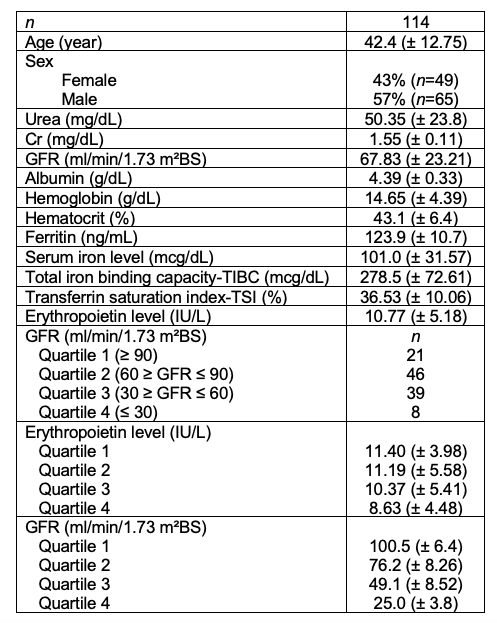
Are serum erythropoietin levels associated with eGFR in Mexican kidney transplant recipients?
Lucino Bahena Carrera1, Carlos Adrián Chávez Mendoza1, Jéssica Reyes Lara1, Miguel Eduardo López Chico1, César Ulises Ramírez Salgado1, Sagrario Castillo Juárez1, Héctor Faustino Noyola Villalobos1.
1Nephrology and Transplant, Central Military Hospital, Mexico City, , Mexico
Introduction: The production of erythrocytes is regulated by the hormone erythropoietin (EPO), which maintains the blood haemoglobin (Hb) levels. Human EPO is a glycoprotein hormone and its synthesis is controlled by the hypoxia-inducible transcription factor.
Panjeta M et al showed that in patients with native kidneys and CKD, GFR positively correlated with Hb and EPO levels, but there aren´t studies that have described this correlation in kidney transplant recipients.
Method: Observational, analytical, transversal and prospective study from January 2021 to February 2023. Were included all G5 KDIGO chronic kidney patients who completed 3 years post-transplant during the study period at Central Military Hospital, Mexico, City. All subjets were divided into 4 subgroups according to their GFR. Serum iron kinetics and erythropoietin levels were determined. Exclusion and elimination criteria were: subjects denied informed consent, those patients with digestive tract bleeding and subjects with erythropoietin use. The Kolmogorov-Smirnov test was performed to determine the normality of the variables, data was reported as median and interquartile range (IQR); descriptive and analytical statistics were performed with Xi², Kruskal Wallis test and ANOVA tests. p< 0.05 was statistically significant.
Results: Were included 114 kidney transplant recipients. On average, kidney grafts are functional, defined by a GFR ≥ 60 ml/min/1.73 m²BS. Whole parameters levels of iron kinetics are normal in our kidney transplant recipients including EPO levels.

There was a correlation trend but without statistical significance between Hb and serum EPO levels (p=0.051), but not between EPO levels and eGFR (p=0.28). Furthermore, we demonstrate an inverse correlation between the creatinine level and the EPO levels (p<0.001).

Discussion: Milkos ZN reported in 886 prevalent kidney transplant recipients the erythropoietin mean was 10.85 IU/L, similar to our results. In native kidneys, EPO deficiency begins early in the course of CKD, but when eGFR ≤ 30 ml/min/1.73 m²BS this deficiency increases.
By other side, Sinnamon KT et al found a significant negative correlation between hemoglobin levels and EPO (Pearson's correlation coefficient, R=-0.29, p< 0.001) but there was no significant correlation between EPO levels and eGFR (R=0.02, p=0.74) in kidney transplants, similar to our results.
Conclusion: In Mexican kidney transplant recipients, the EPO level doesn´t correlate with eGFR. This implies that graft function isn´t the main determinant of serum EPO levels in renal transplant recipients and other factors such as hypoxia-inducible factor (HIF) and hepcidin levels should be analyzed in future prospective studies.
[1] Erythropoietin
[2] Kidney transplant
[3] Glomerular Filtration Rate
[4] hemoglobin
[5] Post-transplant Anemia
[6] Renal function
